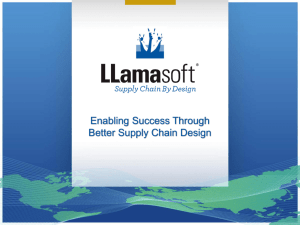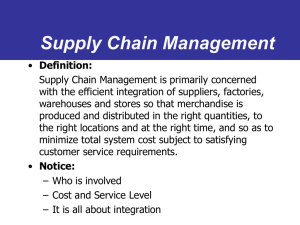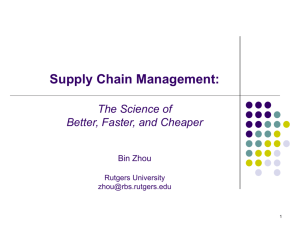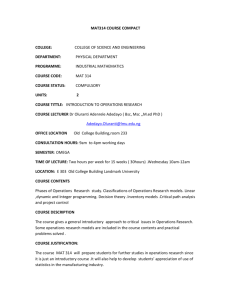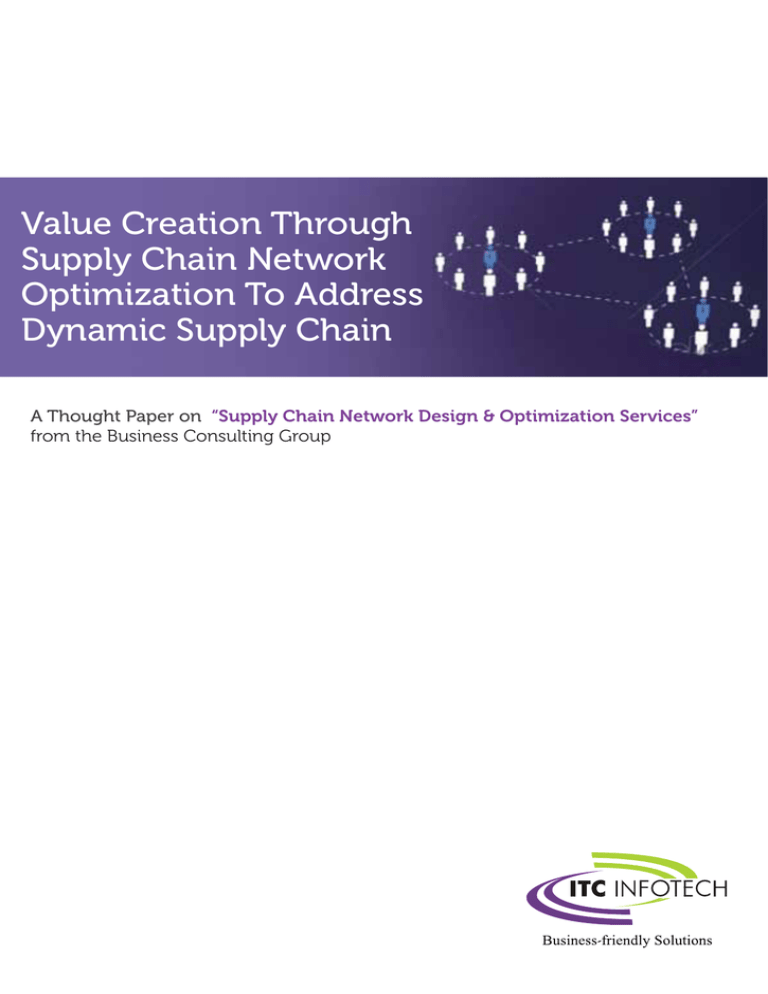
Value Creation Through
Supply Chain Network
Optimization To Address
Dynamic Supply Chain
A Thought Paper on “Supply Chain Network Design & Optimization Services”
from the Business Consulting Group
Introduction
Supply chain management has become one of
the crucial focus areas in many businesses. It
encompasses planning and management of all
activities involved in sourcing, production,
warehousing and distribution of products.
Many companies enjoy significant business
success in lieu of unique ways in which they
have designed their supply chain and how they
react towards changes in internal & external
factors.
Leading businesses operating in developed
nations understood the importance of supply
chain and there is good amount of maturity
level in their processes. This is aided by the
improved infrastructure and fiscal policies in
those countries to a great extent. But majority
of businesses in developing countries such as
India need to go a long way in achieving benefits of a mature supply chain.
To clarify the above point, take the example of
logistics cost. Logistics cost as a percentage of
GDP in countries like US & UK is less than 8%
of GDP, while in India example, it is 14 to 15%
of GDP.
movement by rail is less and it needs further
expansions. Tax benefits rules over the
operational efficiency resulting in increasing
number of stocking points. This, added to
highly fragmented demands, nullifies the
benefits of economies of scale. Indian
economy is growing at a rate of 8% & is
supposed to grow in the same pace till 2020.
By 2025 it is expected to be the world’s fifth
largest economy. There will be a major
population shift to cities and it is expected that
many new growing geographies will come in
existence. So the pattern and geography of
demand picture is expected to undergo major
shift.
As discussed there are macro & micro
economic factors that may lead to sub
optimality in supply chain, and this needs to be
addressed. Many companies are working in
this direction and undertaking supply chain
network redesign exercise to reap benefits in
the short and long term.
Taking India as an example, we highlight the
dynamic and evolving nature of supply chains.
In India, the high logistics costs can be attributed to poor transport infrastructure and to a
great extent the complex fiscal structure
currently existing in India. The freight
2
Dynamic Supply Chain & Value Levers
Many companies are investing in processes, tools and resources to achieve operational efficiency
in supply chain planning. They are going for integrated planning with the objective of increased
customer service level, responsiveness, on time in full delivery and so on. There are many
questions which still remain unanswered and which are related to company’s ultimate objective:
Is the cost factor considered for planning and is it the end-to-end supply chain cost which is
considered?
What is the basis of Cost to Serve models; is it profit maximization/cost minimization?
Is there any consideration of working capital productivity and fixed asset efficiency in
planning?
Is the current network the most suitable one or needs some changes considering current &
future scenarios?
What are the action plans on tactical & strategic level and whether they are aligned?
The figure below shows the linkage between the main organizational value levers and different
supply chain performance attributes. The supply chain performance attributes described boils
down to four main key supply chain levers.
Organizational
Value Levers
Supply Chain
Performance Attributes
Reliability
Increased Free Cash
Flow/ROCE (Current & Future)
Enhance Shareholder Value
Increase Revenue
Responsiveness
Flexibility
Reduce Cost
Supply Chain Costs
Increase Working
Capital Efficiency
Working Capital
Productivity
Increase Fixed Assets
Efficiency
Fixed Asset
Productivity
Improve Future
prospects
Lower Supply
Chain Risks
Key Supply
Chain Levers
Resource Acquisition
Structural Decisions
Operating Policies
Operational Efficiency
3
Resource Acquisition: Acquiring and divesting right resources at right quantum at right
place at right time. Resources can be production units, warehouses etc
Structural Decision: Realignment of capacity, reduction in echelons in network etc
Operating Policies: Policy decisions basis cost to company view. E.g. production strategy to
react to seasonality in demand
Operational Efficiency: Efficient execution & control of day to day operations
One of the most important considerations in supply chain and operations is cost. The supply chain
network optimization model also focuses in optimizing “cost to serve” considering end to end
supply chain cost, while maintaining necessary service level. Hence identifying end-to-end supply
chain cost and cost drivers becomes one of the important considerations in network design
exercise.
Dynamic Supply Chain Cost Structures & the need for Optimization
Companies are increasingly focusing on cost perspective along with service requirements during
planning & design of supply chain network. The initiative goes in a way to find the most cost
optimized way in meeting key objectives for a good supply chain as shown in figure below:
Inventory costs
Facility costs
Transportation costs
Operating costs
Asset costs
Customer satisfaction
Sales growth
Levels of service
Increased market share
Response times
In the current scenario, where market & demand is highly fragmented, companies are coming up
with different models of sourcing & distribution. The supply chain is getting complex and number
of echelons are increasing to get fiscal benefits. Companies have created numerous facilities
(sourcing, manufacturing, Centralized DCs/Warehouses) with tangible & intangible benefits in
mind. While intangible benefits usually based on strategic intent, tangible benefits are mostly cost
based.
4
Figure below gives the set of cost involved in different legs of multi echelon supply chain network:
Suppliers
Raw material basic
Cost
Taxes/ duties
Freight cost
Capacity addition
& realignment cost
Production Plant
Centralized DCs
Conversion fixed cost
Conversion variable cost
Facility fixed cost
Opening/Closing cost
Capacity expansion & realignment cost
Outbound transportation cost
Taxes & Duties
Handling & Inventory cost
Regional
Warehouses
Wholesale
Dealers
Outbound transportation cost
(Primary & Secondary)
Handling cost
Inventory cost
Facility fixed cost
Facility expansion cost
Opening/Closing cost
Taxes & Duties
For companies it becomes very important to make decisions basis end-to-end supply chain cost.
The recommendations coming out of network design exercise when balanced with strategic
intent gives a good picture about the roles of different facilities in supply chain. Because of the
dynamic nature of supply chain, these supply chain network design decisions need to be
periodically revisited.
Drivers for Supply Chain Network Design
The need for supply chain network design can be because of many internal and external factors:
Internal Factors: The supply chain operation is majorly divided into four main functions
namely sourcing, production, logistics and sales/customer service. It has been observed that the
alignment regarding their individual (function specific) and company objectives are not very well
defined which leads to inter functional conflict in objectives. Different functions working on their
individual objectives lead to local optimization and not enjoy the benefits of global optimization.
The cost associated to achieve certain level of service level becomes high when compared to
optimization done in keeping end-to-end cost in picture.
5
CONFLICTING OBJECTIVES
SOURCING
MANUFACTURING
LOGISTICS
Stable volume
Large quantities
Large leadtime
Long runs
Stable volume
High buffer inventory
(RM/FG)
Warehousing
- Less inventory
- Smooth flow
- Less SKUs
Transportation
- Full Truck Load
SALES /
CUSTOMER SERVICE
Availability
Flexibility
Responsiveness (order
cycle time)
External Factors: The supply chain design is based on many factors and should ideally keep
on changing as these factors changes. It is very important to analyze the sensitivity of supply
chain network of a company against changes happening in these factors. Some of the important
factors are:
Demand Factors: Increase/Decrease/Shift in demand, type of demand like regional /
fragmented / homogenous demand
Fiscal Factors: Tax structure & policy change in due course of time
Infrastructural Factors: Availability and cost of labour, transportation facilities and necessary utilities
Competitive Factors: New entrant/existing competitors & competitive intensity, New product
introduction, expansion into new markets, pricing strategy
Because of the impact of internal and external factors, supply chain network becomes suboptimal
over a period. It becomes very important to have periodic assessments carried out to align
network with supply chain strategy considering changes in factors.
Illustration:
Ferdows in his paper “Making the most of foreign factories” has discussed how the roles
associated with manufacturing plants changes because of changes happening in internal &
external factors. He devised a framework to understand the position of manufacturing plant in a
given network. The two dimensions for defining roles of manufacturing plant are reason of
exploitation and level of strategic intent involved.
Reason of exploitation includes low cost input factors, technological knowhow & market
proximity. Level of strategic intent means degree of contribution of plants to the company
strategy. It means plant contribution related to other processes next to production (like product &
process improvement, procurement planning, logistics planning), acting as an innovation partner
with head office and becoming knowledge hub for other plants.
6
For example, plants which have been established in areas like Baddi (H.P) in India are mainly
because of the tax exemptions provided by the Indian government. The period of exemption is
likely to finish in near future. Most of the companies are revisiting the future role to be played by
these manufacturing units. There are three options left with them:
To increase their strategic role
To run plant only to satisfy local demands
To shut them or shift the facilities to other region which are profitable to the company
Any of the three options requires a clear definition in time phase basis on how to manage the
required shift.
Our approach to Supply Chain Network Design
Supply Chain Network Design requires a powerful modeling approach to deliver significant
improvements in supply chain cost structures and service levels. It needs to incorporate modeling
of fixed and variable costs for all the main activities and cost drivers in a supply chain network:
purchasing, production, warehousing, inventory, and transportation. ITC Infotech has devised a
unique approach to model & design supply chain network services – the same is described further
in this paper.
I. Network Design & Optimization Models Overview:
Network Design is a process to determine the unique network configuration for the supply chain
that offers the lowest total cost/ highest total profit considering operational and financial risk while
achieving targeted Service Levels. The figure below gives an illustration of how Network design
exercise helps in finalizing Zone of indifference / Range of indifference where supply chain cost
is minimal basis various tradeoffs involved. In network design exercise performance simulation is
also done to validate the feasibility of supply chain strategies.
Overhead
Risk Adjusted
Network Cost Drivers
Costs ($)
Optimal
Range of
Indifference
Transportation Costs
• Inbound
• Outbound
Inventory Costs
Facility Costs
Total Costs
Number of Warehouses
7
Network design exercise involves many decision variables like location and capacity of facilities,
product – location combination decisions, decisions on transportation lanes etc subject to real
world constraints of capacity, manufacturing, sourcing and serviceability requirements. Thus
supply chain network design provides answers to some of the key questions in supply chain
network.
II. Questions answered by Supply Chain Network Design & Optimization Models:
Long Term
Strategic
Resource
Acquisition
Medium Term
Structural
Decisions
Tactical
Operating
Policies
Short
Term
Operational
Efficiency
Technology required for each of the process
How many manufacturing & distribution facilities
Where should each facility be
How large it should be
Time phase build up of capacity
What process at which facility
What product to be stocked or processed at what facility
What transportation modes & lanes to be used for moving
products
Which market to be served from which facility
How much should I store/ ship and store (especially when
seasonality is present)
Build ahead Inventory & Production strategy
How should I go for process investment e.g.automation
(in time phase manner)
What should be my network flow for monthly demand
What should be my commitment against monthly demand
How should I staff my plant (permanent vs temporary)
Minor exceptions in network structure
The four key supply chain levers explained earlier poses many questions which needs to be
answered. Most of the questions that will be answered by Network design exercise are detailed in
the figure. The strategic & tactical decisions can further be seen as long term, medium term & short
term decisions basis the lead time to finalize and implement the changes.
The table below is basis a leading CPG company in India. It explains the planning horizon,
frequency and bucket for Network design exercise carried out for Short term/Medium Term & Long
term decisions.
Parameters
Short term
Medium Term
Long Term
Horizon
1-3 Months
1-24 Months
1-5 Years
Frequency
Monthly
Quarterly
Semi annually/Yearly
Planning Bucket
Weekly/Monthly
Monthly
Quarterly/Yearly
8
Because of the number of decision variables and constraints involved, it is very difficult to perform
this exercise manually or with excel tools. There are some best in class tools available which can
aid the process of network design
III. Supply Chain Network Optimization tools:
Supply chain network optimization tools provide end-to-end supply chain modeling which includes
sourcing, manufacturing and distribution. These tools provide options to incorporate large number
of constraints with lot of decision variables. The best in class tools in this category are i2 Strategist,
supply chain guru, IBM network optimization workbench etc
Key aspects include its ability to:
Model the entire supply chain from raw materials to finished products to delivery
Improve strategic and tactical decision making with visibility into network design, sourcing and
capacity
Plan for uncertainties with what-if scenario generation and analysis
Understand and project the inventory costs of network design decisions based on stochastic
parameters
Network design projects are usually carried out in multiple logically sequenced steps.
IV. ITC Infotech’s Supply Chain Network Optimization Approach:
Our approach for Network design exercise is a six step approach as given below
As Is Strategy
& Operations
Assessment
Analyze supply
chain processes &
enablers
Map current
operations strategy
Determine supply
chain cost drivers &
constraints
Understand
customer needs
Complexity
reduction &
simplification of
requirements
Develop conceptual
model
Information
Gathering
Detail information
requirements
Baseline
Development
Collect data
required
Define modeling
scope like
processes, facilities
and products to be
considered
Assess data
available & it’s
hygiene
Develop model &
create database
formats
Assess & analyze
information
Detail assumptions
made
Develop time
estimates
Develop activity
based costing
Run & analyze
baseline model
Compare results
with the actual cost
incurred
Scenario
Visioning
Scenario Analysis &
Strategy formulation
Review baseline
assumptions &
result with business
Basis what if
analysis confirm set
of scenarios
Make necessary
changes if needed
Optimize, analyze &
sensitize alternative
strategies
Once model is
confirm do
sensitivity analysis
Develop various
what if scenarios
Perform cross
alternative sensitive
analysis
Detail recommendations from different
scenarios
Recommendations
Run & analyze the
final scenario
Detail the benefits
coming from it
Detail the reasons &
changes need to be
made
Give the final
recommendations &
to be action points
to the business
Basis recommendations finalize the
scenario with
business team
Define the degree of
error for different
cost heads
(Tolerance level)
9
Putting Supply Chain Network Design & Optimization to Work
This is a case study of one of India’s leading CPG companies.
Objective: Recommend “To-Be” supply chain network in short term, medium term & long term
basis minimum overall cost (end-to-end cost involving Vendor-Production Unit-Centralized
DCs-Regional Warehouses)
Background: Our client has a high growth business, with a mature planning process. The business wanted to incorporate holistic cost perspective in planning.
Description:
Our Objective was to design a time based supply chain network, which works on minimum
cost to serve model.
Costs involved - RM/PM landed cost + Conversion cost + Transportation cost + Fiscal
cost + Inventory handling/carrying cost. Different fixed costs and facility opening/closing
costs are also involved
Decision Variables – Vendor - Factory mapping, Factory - DC/Warehouse mapping,
DC-Warehouse mapping, Factory-Product mapping
Subject to – Customer service constraints, Factory Minimum/Maximum Capacity
constraints, changeover constraints, packing constraints & transportation capacity
constraints
Model Outcome:
Finalization of sourcing strategy
Product planning (Where to produce & how much to produce)
Finished goods network from production unit till warehouses – Via centralized DCs vs.direct
to serve to regional warehouses
Capability realignment
Opening/Closing of facilities in time phase manner
10
Summary
Supply Chain Network Design is a powerful
modeling approach which has been proven to
deliver significant reduction in supply chain
cost and improvements in service levels. It
incorporates end-to-end supply chain cost:
purchasing,
production,
warehousing,
inventory, and transportation. Companies can
revisit their network periodically considering
changes in business scenarios like new
product introduction, changes in demand
pattern and new supply sources so as to align
supply chain network. Also companies can
reap cost and competitive advantage by
undertaking supply chain network optimization
exercise in response to big ticket changes in
fiscal policy like change in taxes, tax rebates
etc.
References
Paper by Kasra Ferdows “Making the most
of foreign factories”
11
About the Author(s)
Rohit Shukla is a Lead Consultant in the
supply chain practice at ITC Infotech. He holds
a degree in electrical engineering with an MBA
in operations and supply chain management.
Rohit has over 7 years of experience in supply
chain management in Electronics and CPG
domain.
Jimmy Thomas is a Lead Consultant in the
supply chain practice at ITC Infotech. He holds
a degree in Mechanical engineering with an
MBA in operations and supply chain
management.Jimmy has over 7 years of experience in supply chain management in Automotive and CPG domain.
About the ITC Infotech
Business Consulting group
ITC Infotech’s Business Consulting Group
provides rich business consulting capabilities
across key business functions such as product
design & development, manufacturing & supply
chain management, sales & service, loyalty &
customer relationship management, etc. The
group has expert practices around Enterprise
Performance Management, CRM and Loyalty,
SCM and Operational Excellence, Auto ID
Solutions and Corporate Sustainability. Our
domain experts and management consultants
bring in expertise of addressing customer
needs and problem statements in these areas
across verticals such as CPG, Retail, Process
& Discrete Manufacturing, Travel & Hospitality,
Banking & Financial Services and Logistics &
Transportation.
12
For more information please write to: contact.us@itcinfotech.com
www.itcinfotech.com
© Copyright 2012, ITC Infotech. All rights reserved. No part of this document may be reproduced, stored in a retrieval system, transmitted in any form or by any means, electronic, mechanical, photocopying, recording, or otherwise, without the express written permission from ITC Infotech. The information contained herein is subject to change without notice. All other trademarks mentioned herein
are the property of their respective owners.
13

